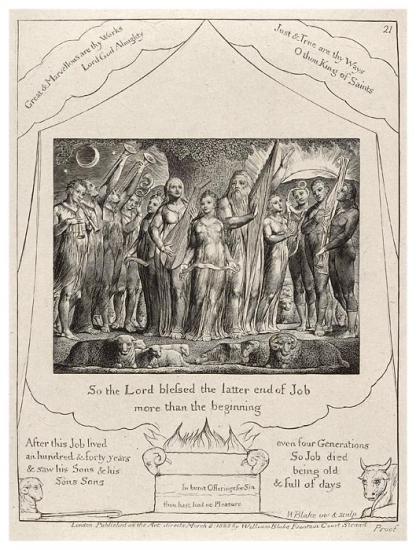
Pl. 21. Job and His Family Restored to Prosperity
Illustrations of the Book of Job
London: Published . . . by William Blake, [1826]
Engravings
Gift of Mrs. Landon K. Thorne, 1973
Job's tribulations engaged Blake's imagination early. A tempera painting called Job and His Daughters, executed about 1799 or 1800 for Thomas Butts, is an example. Butts also commissioned the watercolor series that you see behind you, which was produced between 1805 and 1810 and comprised nineteen drawings. In 1821, Blake borrowed them to copy for John Linnell. At that time two new drawings (pls. 17 and 20) were added, extending the group to twenty-one. In 1823, with Linnell's encouragement and financial support, Blake re-created the images as a series of magnificent engravings that were published in 1826. The border motifs were designed directly on the plate.
At his death, Blake was working on another brilliant series of engravings, this time devoted to Dante. Copies of that work are also in the Morgan's collections.
William Blake (1757–1827) occupies a unique place in the history of Western art. His creativity included both the visual and literary arts. In his lifetime he was best known as an engraver; now he is also recognized for his innovative poetry, printmaking, and painting. Blake's keen perception of the political and social climate found expression throughout his work. His strong sense of independence is evident in the complex mythology that he constructed in response to the age of revolution.
Blake was already recognized as an engraver at age twenty-five, when his first volume of poems appeared. At thirty-three, in The Marriage of Heaven and Hell, he audaciously claimed that his birth had marked the origin of a "new heaven" in which his own art would exemplify the creativity prefigured by Milton and Michelangelo. By that time, Blake, in one of his most productive periods, had already produced Songs of Innocence and was at work on a series of illuminated books. In 1818 he met John Linnell, a young painter and engraver, through whom a group of young artists became Blake's followers. Calling themselves the Ancients, they helped perpetuate Blake's influence for generations.
The Morgan's Blake collection—one of this country's most distinguished—began with purchases as early as 1899 by Pierpont Morgan. During the tenure of Charles Ryskamp, director from 1969 to 1986, major gifts almost doubled the size of its Blake holdings. In recent years Ryskamp's own gifts of engravings, letters, and related materials have significantly enriched its scholarly resources.
This online exhibition is presented in conjunction with the exhibition William Blake's World: "A New Heaven Is Begun" on view September 11, 2009, through January 3, 2010.
This exhibition is made possible through the generosity of Fay and Geoffrey Elliott.
